My original article on rating draft classes (Best Draft Classes) was written two years ago. How time flies.
Since that article’s publication, two other Draft Classes have played enough to become eligible for evaluation: the Classes of 2017 and 2018. Let’s find out how they compare to the earlier Classes.
Class Valedictorians
I’m not such a big fan that I can remember the details of where every player was picked in every draft, or even which player was picked in what draft. The following tables show the top six players from the Classes of ’17 and ’18, based on their total PR-Score in the first six seasons after their draft.
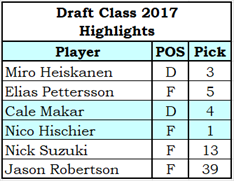
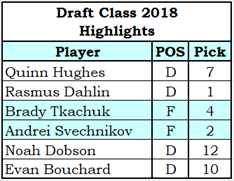
The top talent that came out of both of those drafts looks to be solid.
Unit of Evaluation for Evaluating Draft Classes: Return From Play
Stapled to the Bench (STTB) has a set of statistics for a player’s season: Productivity Rating. PR-Score is a player’s season’s numeric rating, and PR-Category is the group that the PR-Score puts him in. The table below shows one forward from each PR-category from the 2023-24 season, along with the main statistics that drive the value of PR-Score (time-on-ice and scoring).
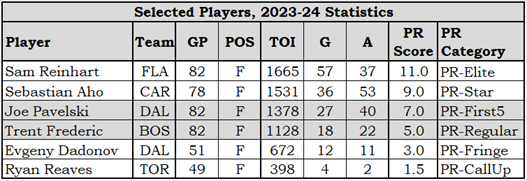
Yes, I know, Reaves is overvalued, but the PR formula is the same for all players, regardless their name.
I could have used PR-Score to evaluate draft classes. A Draft Class’s score would have been the sum of PR-Scores from all its draftees in their first six seasons after the draft. That would have produced an arbitrary number on an unknown scale: for example, the Draft Class of 2013 had a total PR-Score of 894.
I thought I could do better than “an arbitrary number on an unknown scale.” I could produce an arbitrary number on a known scale: money. Then I could take away the arbitrariness.
I decided to convert seasonal PR-Scores to a dollar value, calling the resulting number Return From Play (RFP). It estimates what portion of a team’s salary cap ($80M) players provided based on their PR-Scores. The next table shows the six players from the earlier table with their 2023-24 RFP.
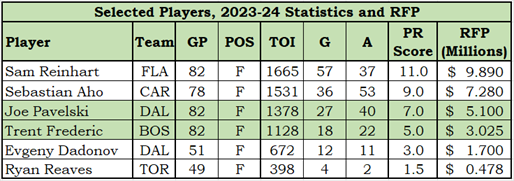
Yes, I know, Reaves is overvalued, but the RFP formula is the same for all players, regardless of their name.
The Draft Class of 2013, which had a total PR-Score of 894, has a total RFP of $537M. While the unit of measurement (dollars) is familiar, the number is still arbitrary.
The total of any of the common NHL statistics of a large group of players over six seasons will be an impressively large number in a known unit. For example, the players of the Class of 2013 scored 1,959 goals in the first six seasons after their draft.
Is 1,959 goals high or low? Is $537M high or low? To reduce the arbitrariness of the data we need context: we have to see what the other Draft Classes did in their first six seasons.
RFP – All Draft Classes
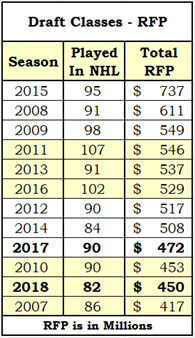
The Draft Classes RFP table shows the Draft Class (Season), the number of their drafted skaters who played at least one game in the NHL in the first six seasons after their draft, and the total RFP generated by all drafted skaters in those first six seasons.
As it turns out, the 2013 Draft Class’s RFP of $537M is close to the average for a Draft Class, which is $527M.
If you’ll pardon me for a slight side discussion, the Class of 2015 needs to be appreciated. This was the Connor McDavid class, but if you remove McDavid’s RFP from it, it would still be the best Class. Ivan Provorov was the second-best player of that draft. If you remove McDvaid’s and Provorov’s RFP from the Class of 2015, they would still be the best Class. And if you also removed third-placed Sebastian Aho’s RFP from their class, Draft Class 2015 would still be the best. Seven players from the Class of 2015 had an RFP above $25M. No other class had more than five such players.
Now, back to the main topic: both the 2017 and 2018 Draft Classes ($472M, $450M) are below average. They are in ninth and eleventh place, respectively, out of twelve classes.
That seems a little harsh, doesn’t it? As was shown in the Draft Class Highlights tables, the top players from these Classes were impressive. How did their classes end up so lowly rated?
As Ricky Ricardo would have told me, “Mike, you got some ‘splainin’ to do.”
RFP – All Draft Classes – Return From Top Ten Picks Thereof
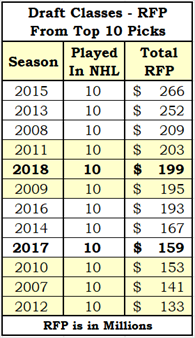
The RFP of the top ten picks of an average draft class is $189M. The 2018 Draft Class was slightly above average ($199M) and the 2017 Draft Class was below average ($159M).
Now, let’s look at the RFP of the ten best players that came out of each Draft Class.
RFP – All Draft Classes – Return From Ten Best Players Therefrom
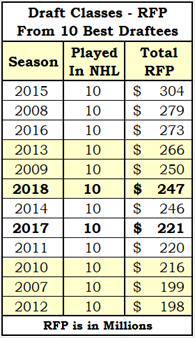
Your average Draft Class’s return from its ten best players is $243M. The 2018 Class was slightly above average ($247M) while the 2017 Class was below average ($221M).
Whichever way one looks at it, the top talent of the 2018 Class is average while the top talent of the 2017 Class is below average.
What else is there to look at? We must look at the RFP they got from every other player in their respective classes.
RFP – All Draft Classes – Every Other Player
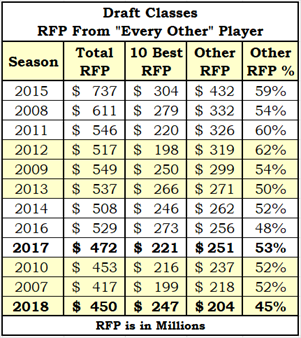
Here at STTB, Draft Classes are evaluated based on the accomplishments of all of its draftees (except goalies, so about 150 skaters), not just their ten best players.
This table shows the RFP contributed by “every other” player, a group that consists of all drafted skaters except for the ten best skaters.
The average RFP for every other player in a draft (in the Other RFP column) is $284M. The Class of ’17 is below average and the Class of ’18 is way below average.
My ‘splainin’ is done; the numbers have spoken. While the valedictorians of 2017 and 2018 are impressive (as valedictorians should be, as the valedictorians of other Classes are), these two Classes are rated lowly due to their lack of depth.
I’ll finish this article with one more set of tables that show two groups of ten players from the 2017 and 2018 Draft Classes: the ten best players of each draft and the first ten players drafted.
Draft Classes 2017 and 2018 – Ten Best Players, Top Ten Picks
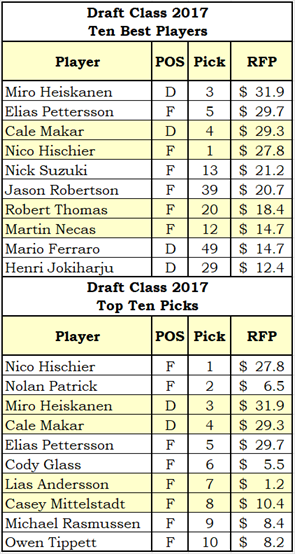
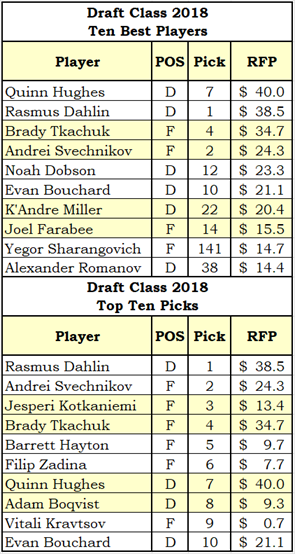
These last tables reflect the difference in top-level talent from the two classes.
With regard to top talent, the Class of 2018 is clearly better. Only one player from 2017 has a better RFP than his 2018 counterpart (4th place, Hischier $27.8M, Svechnikov $24.3M).
The Class of 2017 had three top-ten disappointments (Patrick, Glass, and Andersson), while the only top-ten disappointment in 2018 was Kravtsov.
Draft Classes – What the Future Holds
I took a look at the Draft Classes of 2019 and 2020, the next two classes that are coming up for evaluation. At their current rate of production, by the end of the 2025-26 season, these classes will be last and third-last.
Jack Hughes (F, N.J) and Moritz Seider (D, DET) are the best players to have come out of the 2019 draft. Tim Stutzle (F, OTT) and Lucas Raymond (F, DET) are the best players from the 2020 draft.
Alexis Lafreniere (F, NYR), the first pick of the 2020 draft, took a huge step forward this year and is now the third-best player from this draft. He might pass Lucas Raymond and secure his position as the second-best 2020 draftee, if: Lafreniere continues to improve and Raymond does not improve, or; if Raymond gets injured and Lafreniere remains healthy.
Summary
If you compare this article to my earlier Draft Class article, you will notice small differences in the RFP of Draft Classes. That was caused by the way RFP was calculated this time, specifically by the way PR-Score was reduced to one decimal of precision.
A player’s RFP is based on a PR-Score with one decimal of precision (7.4, for example), while a PR-Score has four bytes of precision (7.3728, for example). For my first article, I rounded the detailed PR-Score to one decimal of precision: 7.3728 became 7.4.
I have no idea why I rounded PR-Score, as I normally truncate it. Truncate means “to shorten by cutting off the end”. When 7.3728 is truncated to one decimal of precision, it becomes 7.3.
In the RFP system, changing 7.4 to 7.3 drops the RFP from $5.54M to $5.43M, a difference of $110,000. While it is a small change, it is a change, and I would be doing you a disservice if I did not both let you know it happened and tell you why it happened.
Related Articles
